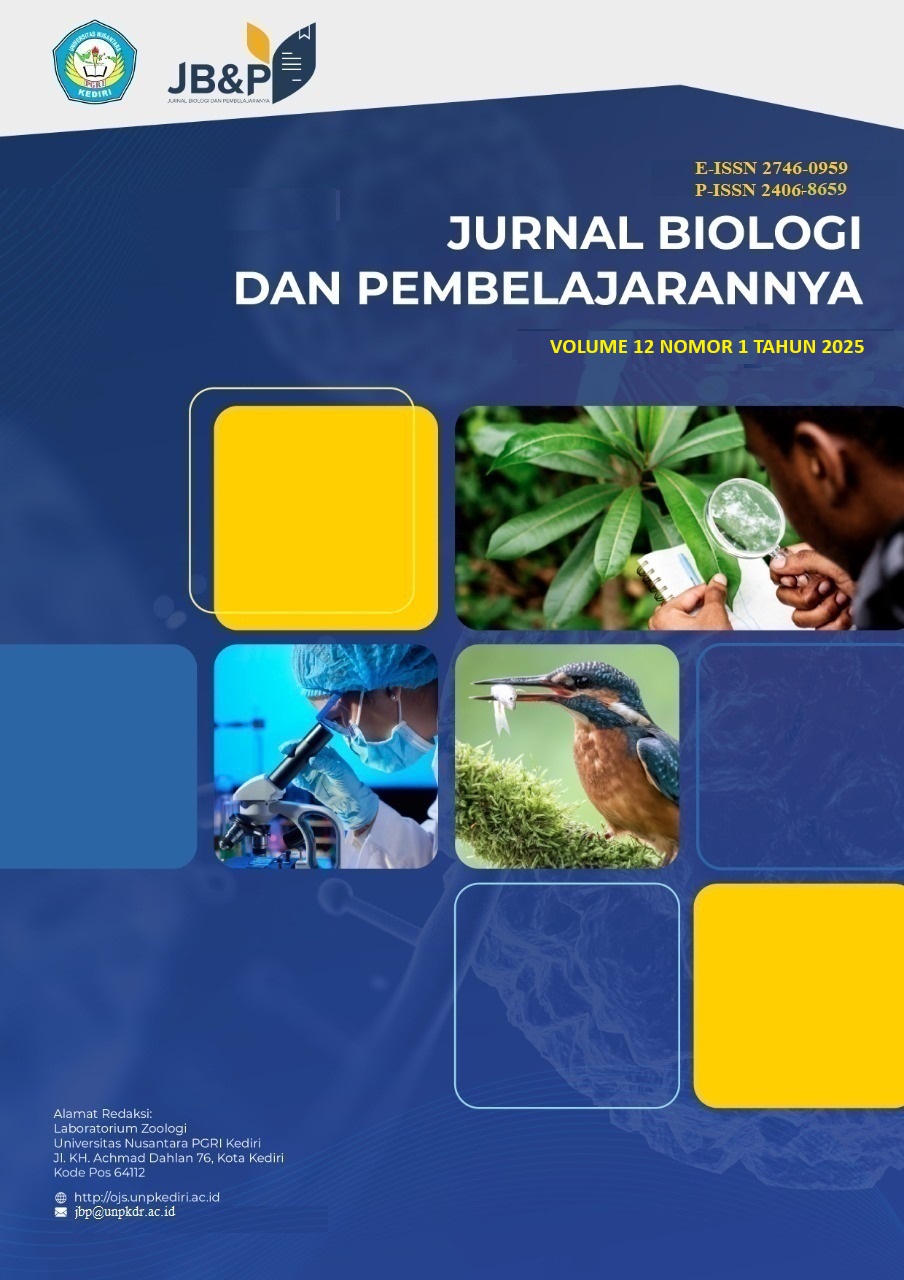Perbedaan Pengaruh 2,4-Dichlorophenoxyacetic acid dan Salicylic Acid Terhadap Produksi Biomassa Kultur Suspensi Sel Zingiber officinale var. Rubrum
DOI:
https://doi.org/10.29407/jbp.v12i1.25062Keywords:
jahe merah, suspensi sel, 2,4D, asam salisilatAbstract
Optimasi jenis zat tumbuh untuk kultur suspensi sel jahe merah perlu dilakukan karena keterbatasan produksi jahe merah skala lapang. Penelitian ini bertujuan untuk membandingkan pengaruh 2,4D dan asam salisilat secara terpisah terhadap kultur suspensi sel jahe merah. Penelitian dilaksanakan dengan metode eksperimen. Subkultur kedua suspensi sel jahe merah yang telah diketahui kurva pertumbuhannya diberi 2,4D dan asam salisilat secara terpisah dengan konsentrasi 1,2, dan 3 ppm pada medium cari MS basal. Penelitian ini mengungkapkan bahwa 3 ppm konsentrasi 2,4D lebih efektif dibandingkan asam salisilat dalam meningkatkan berat basah, berat kering, dan Settled Cell Volume
References
Aini Dania, I., Rusdiana, R., S. Rambe, A., Harahap, U., Effendy, E., & Novziransyah, N. (2024). Active Compounds of Red Ginger as Antioxidant Activity in the Supplementation and Treatment of Depression. Qubahan Academic Journal, 4(1), 177–184. https://doi.org/10.48161/qaj.v4n1a208
Al-Khayri, J. M., & Naik, P. M. (2022). Influence of 2iP and 2,4-D Concentrations on Accumulation of Biomass, Phenolics, Flavonoids and Radical Scavenging Activity in Date Palm (Phoenix dactylifera L.) Cell Suspension Culture. Horticulturae, 8(8), 683. https://doi.org/10.3390/horticulturae8080683
ALVES DOS SANTOS, M. R., & SOUZA, C. (2019). Effect of 2,4-D and BA on the establishment of cell suspension from nodes and internodes of Capsicum annuum cv. Etna. International Journal for Innovation Education and Research, 7(5), 55–61. https://doi.org/10.31686/ijier.vol7.iss5.1460
Batubara, I., Badrunanto, -, Wahyuni, W. T., & Farid, M. (2023). Combination of Extraction and Distillation Red Ginger Rhizome on the Composition of Active Compounds and Tyrosinase Inhibitory Activity. International Journal on Advanced Science, Engineering and Information Technology, 13(2), 431–437. https://doi.org/10.18517/ijaseit.13.2.17606
Chauhan, A. P. S., Yadav, S. K., Parihar, C., Sharma, S., Kushwah, N., & Bagri, U. S. (2023). Role of Salicylic Acid in Mitigating Stress and Improving Productivity of Crops. International Journal of Plant & Soil Science, 35(22), 579–588. https://doi.org/10.9734/ijpss/2023/v35i224168
Fidemann, T., de Araujo Pereira, G. A., Heluy, T. R., Gallego, R. B., Bertão, M. R., da Silva, R. M. G., & Fernández Núñez, E. G. (2018). Handling culture medium composition for optimizing plant cell suspension culture in shake flasks. Plant Cell, Tissue and Organ Culture (PCTOC), 133(1), 137–146. https://doi.org/10.1007/s11240-017-1368-3
Gatz, A., Tomaszewska-Sowa, M., & Figas, A. (2017). Changes accompanying proliferative capacity and morphology of Nicotiana tabacum L. callus in response to 2,4-D. Acta Agrobotanica, 70(4). https://doi.org/10.5586/aa.1725
Hendra, R. J., Rusdi, R., Asra, R., & Misfadhila, S. (2022). Phytochemical and Traditional Uses of Red Ginger: A Review (Zingiber officinale var. rubrum). EAS Journal of Pharmacy and Pharmacology, 4(3), 50–55. https://doi.org/10.36349/easjpp.2022.v04i03.002
Karami, O., de Jong, H., Somovilla, V. J., Villanueva Acosta, B., Sugiarta, A. B., Ham, M., Khadem, A., Wennekes, T., & Offringa, R. (2023). Structure–activity relationship of 2, 4‐D correlates auxinic activity with the induction of somatic embryogenesis in Arabidopsis thaliana. The Plant Journal, 116(5), 1355–1369. https://doi.org/10.1111/tpj.16430
Li, A., Sun, X., & Liu, L. (2022). Action of Salicylic Acid on Plant Growth. Frontiers in Plant Science, 13. https://doi.org/10.3389/fpls.2022.878076
Liang, Y., Li, D., Sheng, Q., & Zhu, Z. (2023). Exogenous Salicylic Acid Alleviates NO2 Damage by Maintaining Cell Stability and Physiological Metabolism in Bougainvillea × buttiana ‘Miss Manila’ Seedlings. Plants, 12(18), 3283. https://doi.org/10.3390/plants12183283
Loyola-Vargas, V. M., & Ochoa-Alejo, N. (2012). An Introduction to Plant Cell Culture: The Future Ahead (pp. 1–8). https://doi.org/10.1007/978-1-61779-818-4_1
Miri, S. M. (2020). Micropropagation, Callus Induction and Regeneration of Ginger ( Zingiber officinale Rosc.). Open Agriculture, 5(1), 75–84. https://doi.org/10.1515/opag-2020-0008
Rukhayyah, K. K., Kawareng, A. T., & Sastyarina, Y. (2022). Studi Literatur: Uji Aktivitas Antioksidan Ekstrak Jahe Merah (Zingiber officinale var. Rubrum) Menggunakan Metode 2,2- diphenyl-1-picrylhydrazyl (DPPH). Proceeding of Mulawarman Pharmaceuticals Conferences, 15, 242–245. https://doi.org/10.25026/mpc.v15i1.648
Salinas, P., Velozo, S., & Herrera-Vásquez, A. (2024). Salicylic acid accumulation: emerging molecular players and novel perspectives on plant development and nutrition. Journal of Experimental Botany. https://doi.org/10.1093/jxb/erae309
Shaukat, M. N., Nazir, A., & Fallico, B. (2023). Ginger Bioactives: A Comprehensive Review of Health Benefits and Potential Food Applications. Antioxidants, 12(11), 2015. https://doi.org/10.3390/antiox12112015
Tsolmon, M., Oyundari, G., Yu, O., & Senthil, K. (2020). Establishment of callus and cell suspension culture of Sophora alopecuroides Linn. for the production of oxymatrine. Journal of Phytology, 35–39. https://doi.org/10.25081/jp.2020.v12.6308
Downloads
Published
Issue
Section
License
Copyright (c) 2025 Frida Kunti Setiowati, Nina Aulia Rahmah Permatasari

This work is licensed under a Creative Commons Attribution-ShareAlike 4.0 International License.
Authors who publish with this journal agree to the following terms:
- Copyright on any article is retained by the author(s).
- The author grants the journal, right of first publication with the work simultaneously licensed under a Creative Commons Attribution License that allows others to share the work with an acknowledgment of the work’s authorship and initial publication in this journal.
- Authors are able to enter into separate, additional contractual arrangements for the non-exclusive distribution of the journal’s published version of the work (e.g., post it to an institutional repository or publish it in a book), with an acknowledgment of its initial publication in this journal.
- Authors are permitted and encouraged to post their work online (e.g., in institutional repositories or on their website) prior to and during the submission process, as it can lead to productive exchanges, as well as earlier and greater citation of published work.
- The article and any associated published material is distributed under the Creative Commons Attribution-ShareAlike 4.0 International License













